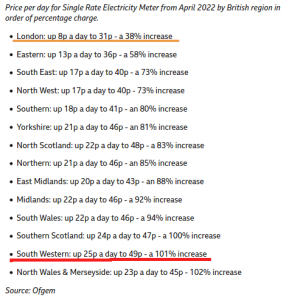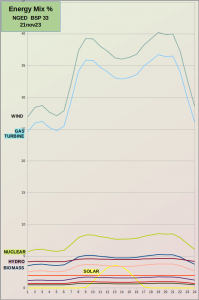Posted by: @transparentIf 'we' were to change the way we live by reducing demand at peak times (ToU tariffs) and storing energy in batteries, then we would flatten the curve for peak-demand.
I think de-electrification of heat would go a long way towards that. There is a lot of talk on LinkedIn about district heating/heat networks. The Energy Act 2023 provides a new basis for heat networks to be regulated. https://www.raponline.org/knowledge-center/warming-up-to-it-principles-clean-efficient-smart-district-heating/ also emphasises the importance of heat networks.
The de-electrification (at least from a user’s perspective) would happen as an implementation detail. For instance it could be through use of industrial waste heat. If it can for the most part avoid passing heat through a heat pump it would also break the link between heat and the price of electricity (and so currently the price of gas == current price of heat). I know of one non-combustion technology which already enables district heating from waste heat, although Germany appears to have phased it out.
Posted by: @transparentThe question is...
... can the UK actually afford such a massive grid upgrade?National Grid is funded through customer bills, not government taxation.
So to send enough wind-power to SE England from the North Sea and the far reaches of Wales and the West Country, a great many more of the population in those localities will be plunged into energy-poverty.
This is not merely a technical issue, but an ethical one.
Who is going to be paying for the infrastructure upgrades so that the more affluent residents in the South East can charge their EVs and hence use the Greater London ULEZ?
@transparent The issue is that energy policy is irrational. We are putting in offshore wind turbines at 3x cost because onshore wind turbines are verboten for a whole bunch of NIMBYs. All that power has also to be routed through a greatly expanded grid over long distances (again verboten to NIMBYs). The amortised infrastructure cost of this absurdity just doesn't fall on the electric SUV charger in the South East but gets spread throughout the country, including onto the poor on prepayment meters. There are just no consequences in this kind of world and consequently, behaviour, both in electricity consumption and politically, won't change. If the Southeast (or anywhere else) wants cheaper renewables, they should have to generate closer to home or pay a lot more for it (via some escalating tariff that recognizes their increased draw required use of long distance infrastructure to fulfill demand, effectively a load-smoothing tariff).
From a household point of view, when I've been considering battery storage, there are two key considerations - how much can I earn/save per charge discharge cycle and how many charge/discharge cycles can I have daily/weekly/etc. Storing my own solar generation, while cost effective per cycle, is only possible for around half the year which isn't really enough to justify the cost very much storage by itself. There's the opportunity to arbitrage TOU prices at other times but even those are uncertain. I can't imagine there being any long-term rationale for low night time prices when everyone is charging their EV. How frequently will such opportunities for arbitrage arise in future? And when these opportunities arise, the standard rules restrict my export to a piddling amount anyway, perhaps only enough to partly offset another household's EV fast charger. I'm prepared to put in a fair bit of storage, but not at a net loss.
Posted by: @ronin92The amortised infrastructure cost of this absurdity just doesn't fall on the electric SUV charger in the South East but gets spread throughout the country
Not so. It's actually even less 'fair' than you imagine.
Once a DNO Region is exhibiting surpluses of electricity from renewable sources, it is primarily the Distribution Grid which requires upgrading.
So if the over-supply originates from the commercial wind-turbines along the north coast of Cornwall & Devon, which are connected at the 11kV and 33kV levels, then the infrastructure upgrade costs fall on consumers in that region.... not London, where the electricity is required.
It's only upgrades to the 400kV National Transmission Grid which are spread across GB.
The first time that such major upgrades were reflected in the DNO caps approved by Ofgem was in April'22.
Here's a screenshot I took from an online news site when the announcement of Standing Charge increases was made in March:
I did subsequently go through the BEIS/Ofgem spreadsheets which described the 13 categories of costs that go into the Standing Charge calculations.
They are great deal more complex than the press headlines would suggest,
and I was unable to understand the formulae sufficiently to confirm the above figures.
Save energy... recycle electrons!
Posted by: @ronin92Storing my own solar generation, while cost effective per cycle, is only possible for around half the year
Please clarify this @ronin92
Which DNO Region do you live in?
Apart from two days, I have been able to store sufficient electricity from my rooftop solar arrays to run the house over the past 3 weeks of November.
By that I mean that there were only two days when I needed to import electricity from the grid to my batteries.
Is this because:
- I live in SW Region, where the prevailing SW wind has been pushing away the storm clouds quickly?
- I have enough battery storage to tide over our household consumption for relatively long periods?
Posted by: @ronin92I can't imagine there being any long-term rationale for low night time prices when everyone is charging their EV.
That's quite correct.
The classic Economy-7 tariff has to be replaced...
... so it's bizarre that so many domestic electricity suppliers are basing their EV tariffs on it!
GB needs to move across to Nodal Pricing.
That's where the price per kWh varies each time-period according to the demand/generation calculations which apply to your location.
We can already demonstrate that from the available electricity forecasts.
For example this is the energy mix which I will be receiving from the Distribution Grid for my location tomorrow, 21st Nov:
I can multiply that by the total demand for each time period within my location (calculated by NG-ESO)
and the cost for each energy type.
That much is easy.
The delays are down to:
- ratification by the SEC
- approval by Ofgem
- implementation by the Energy Suppliers within their billing systems
Save energy... recycle electrons!
Posted by: @transparentPlease clarify this @ronin92
Which DNO Region do you live in?Apart from two days, I have been able to store sufficient electricity from my rooftop solar arrays to run the house over the past 3 weeks of November.
By that I mean that there were only two days when I needed to import electricity from the grid to my batteries.Is this because:
- I live in SW Region, where the prevailing SW wind has been pushing away the storm clouds quickly?
- I have enough battery storage to tide over our household consumption for relatively long periods?
Posted by: @ronin92The issue for me is not region but E-W arrays on my roof. While it works fine in summer with generation almost identical to S-facing arrays, but it falls off quickly towards winter. At least from simulating batteries based on generation records over a year, it's hard to justify more than 3~4 kWh storage without some arbitrage in the off-season as it would mean a large fraction of potential capacity underutilised. But a small battery also means I will fail to capture all my generation in summer (so must be diverted to heat DHW and valued at gas price). The more price arbitrage I can do, the larger a battery I can justify and that also improves the amount of summer generation I can salvage as electricity.
P.S. My diverter only took 0.87 kWh in the last week which tells you how little is storable in winter.
@transparent I feel that summat is a little unfair here! Living in the south east of England, I have seen precious little sun in the last few months and solar production this week has been in the region of 2-3.5 kW/h per day. I have 8.1 kWp of PV panels variously sited on roofs and in the garden though at best, they are slightly off from dead south orientation. For the first 20 days of November, the total solar production was 116 kW/h. Even without the ASHP, our daily consumption (including DHW via the Sunamp Thermino) is approximately 14-15 kW/h. Err… can we run an extension cable from yours to mine please?😉 Regards, Toodles.
Toodles, heats his home with cold draughts and cooks food with magnets.
Posted by: @transparentPosted by: @ronin92The amortised infrastructure cost of this absurdity just doesn't fall on the electric SUV charger in the South East but gets spread throughout the country
Not so. It's actually even less 'fair' than you imagine.
Once a DNO Region is exhibiting surpluses of electricity from renewable sources, it is primarily the Distribution Grid which requires upgrading.
So if the over-supply originates from the commercial wind-turbines along the north coast of Cornwall & Devon, which are connected at the 11kV and 33kV levels, then the infrastructure upgrade costs fall on consumers in that region.... not London, where the electricity is required.
It's only upgrades to the 400kV National Transmission Grid which are spread across GB.
The first time that such major upgrades were reflected in the DNO caps approved by Ofgem was in April'22.
Here's a screenshot I took from an online news site when the announcement of Standing Charge increases was made in March:
-- Attachment is not available --
This is terrible! Is there any amortisation component in the transmission charges that allows the victim (e.g.Devon+Cornwall) to recover this from probable users in, say, London? If not, there should be.
If the standing charge remains, I would prefer it was exactly the same across the country.
Personally I am uncomfortable about some of the basics of life like water and electricity being a different price depending on where people live.
Personally I am also uncomfortable about nodal pricing for the same reason unless there is some levelisation across the country built into the model. I support the idea that 30min slots don't align at each node and consumers should be incentivised if they are using ToU type tariff. I definitely don't support a model that might leave parts of the country with desperately high costs as a side effect of nodal pricing.
Good comments are being made about standing charges.
But can I please remind contributors that it is Ofgem to whom these must be made.
You can read their Call for Input here and the email address for submissions is at the foot of that page.
Note that they are asking for positive input, which form the basis of a statutory consultation.
They want ideas for future strategy, not just a list of complaints about things being 'unfair' in various respects.
This is the moment to propose the basis of the forthcoming consultation.
Other issues, such as grid upgrades and nodal pricing should be discussed here on this topic
They can be viewed here by National Grid and the "Pathway to Net Zero" planning strategy group, which includes DNOs.
Save energy... recycle electrons!
Posted by: @transparentThe classic Economy-7 tariff has to be replaced...
... so it's bizarre that so many domestic electricity suppliers are basing their EV tariffs on it!
I suppose this is where consumer acceptance of variability comes in. Intentional charging (setting requirements) may be a good way ahead but requires user adaptation; I suppose owning an EV suggests a certain level of flexibility.
Posted by: @transparentThey are great deal more complex than the press headlines would suggest,
and I was unable to understand the formulae sufficiently to confirm the above figures.
I hope they did some sanity checking on their spreadsheet; as a software developer this kind of hackery makes me nervous. Nonsensical results are easy with a stray $ or two!
@chickenbig You sense the possibility of problems on the ‘Horizon’? Does it make you a bit fujitzi? Regards, Toodles. (Sorry 😉)
Toodles, heats his home with cold draughts and cooks food with magnets.
- 26 Forums
- 2,323 Topics
- 52.1 K Posts
- 418 Online
- 5,979 Members
Join Us!
Podcast Picks
Latest Posts
-
RE: Heat Pump Training vs. Real-World Installation
@judith I looked at the control challenge of balancin...
By Lucia , 3 minutes ago
-
RE: Grant Aerona circulation/system pump staying on
@mikefl thank you, I've changed 4200 to 2 and now the m...
By damonc , 1 hour ago
-

RE: Solar panels on side of house to heat water
The original strategy behind the production of bi-facia...
By Transparent , 1 hour ago
-
RE: Solis S6-EH1P8K-L-PLUS – Why I Chose It and What I’ve Learned So Far
@batpred I've had a bit of time to look into this to...
By Bash , 3 hours ago
-
RE: Flow rate discrepancy between ASHP and manifold
Air release valves dont always work! You are gonna ha...
By JamesPa , 3 hours ago
-
RE: Replacing my 18 month old Hitachi Yutaki ASHP
Fair enough. I recommend quizzing him to get your mone...
By JamesPa , 4 hours ago
-
RE: Havenwise App Help & Forum Support – Get the Most from Your Heat Pump
@simonwig Thanks for the bump. Not sure why I didn't se...
By HCas , 7 hours ago
-

RE: Are Water Companies Delivering Bricks?!
...which in turn reminds me of a Thelwell cartoon I onc...
By Majordennisbloodnok , 7 hours ago
-
RE: Our journey through Octopus tariffs 2020-2025
I mentioned above "2025 move to Intelligent Go meant ...
By Tim441 , 7 hours ago
-

RE: Testing new controls/monitoring for Midea Clone ASHP
@benson — thank you, that is useful information you hav...
By cathodeRay , 10 hours ago
-

RE: Electricity price predictions
My apologies. I should've written "The number and dep...
By Transparent , 10 hours ago
-
RE: Help…my NIBE heat pump has faulted again!
If it happens only when it gets cold then it maybe that...
By JamesPa , 11 hours ago
-
RE: Grant Aerona3 - Home Assistant control via Modbus
Has anyone got past this screen to set up the integrati...
By AlanW1212 , 11 hours ago
-
RE: Diagnostic Data Needed for Repeatedly Failing Tesla Powerwall 3 System
You seem to be on the right track... Installers are rec...
By Batpred , 20 hours ago
-
RE: Should Our Water Circulation Pump Be Configured to Run All The Time?
there's a detect cycle setting (4200) on the old grant ...
By damonc , 22 hours ago
-
RE: Commencing on an ASHP Installation Process
@sheriff-fatman It's also worth highlighting that th...
By Lucia , 23 hours ago
-
RE: Hitachi Yutaki SCombi Heat Pump - Owners
. It does but, unless there has been a firmware updat...
By JamesPa , 1 day ago
-
RE: Help me keep the faith with my air source heat pump installation
Yesterday it was chilly and the cosy6 had a Cop of 4.3 ...
By AgentGeorge , 1 day ago
-
RE: Solar Power Output – Let’s Compare Generation Figures
@toodles Same here! This month 187kw.
By Andris , 1 day ago






